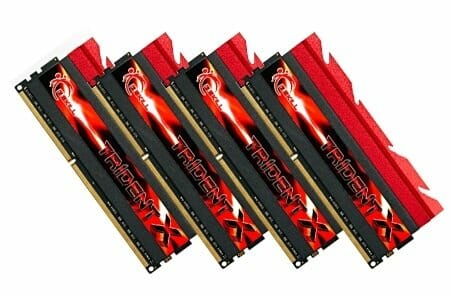32 GB (4 x 8 GB) DDR3 SDRAM Memory Kits from G.Skill Review

Installing four memory modules with a total capacity of 32 GB into a system with a dual-channel memory controller hasn’t been such a big deal lately. Let’s check out a few overclocker kits from G.Skill that could fit the bill perfectly.
We’ve tested a number of memory kits in our labs, yet there are still quite a lot of interesting products we have not covered in our reviews. One of the topics we’ve avoided until now is dual-channel memory kits that consist of more than two DDR3 SDRAM modules. Meanwhile, such products are widely available and, unfortunately, not always regarded as they should be. The fact is we’ve all got accustomed to overclocker-friendly memory kits that comply with a rather straightforward formula: the number of modules equals the number of memory channels provided by the platform. So any memory kit that consists of four DDR3 SDRAM modules seems to be quad-channel and targeted at flagship LGA2011 configurations. This reasoning doesn’t work in every case, however.
First of all, nearly every midrange and top-end mainboard for CPUs with dual-channel memory controller comes with four DDR3 SDRAM slots, so the infrastructure is ready. Second, today’s controllers provide broad opportunities for using 4-piece memory kits. It doesn’t actually matter how many modules of DDR3 SDRAM, one or two, are installed on each channel. Using four memory modules on a platform with a dual-channel memory controller used to have some limitations concerning memory frequency and latencies, but there are no such restrictions anymore. Yes, putting two modules on each channel makes the controller work more, but today’s CPUs can handle the increased load well enough.
Intel CPUs of the Ivy Bridge family are especially good in this respect. Their memory controller has been optimized significantly compared to their Sandy Bridge predecessors. As a result, there are no limitations on installing high-speed DDR3 SDRAM even if we’re talking about overclocked operation modes. At the time of their announcement Ivy Bridge CPUs were known to be able to clock system memory at frequencies up to DDR3-3000 even if all of the memory slots were occupied, and by today we’ve got a lot of evidence confirming their ability to work with four high-speed memory modules. The most convincing proof is in the memory compatibility lists published by mainboard makers. According to them, Ivy Bridge CPUs are quite indifferent to how many and which type of memory modules are installed on each memory channel.
The manufacturers of overclocker-friendly memory modules have used the situation to their advantage by building a whole class of products out of 4-piece dual-channel memory kits for Ivy Bridge CPUs. Such offers are fundamentally different from ordinary 2-piece DDR3 SDRAM kits in their impressive capacities which are getting more popular due to the low prices we have today. Clearly, four memory modules may be twice the capacity of a typical 2-piece dual-channel product. Considering that the maximum capacity of one DDR3 SDRAM module is limited by the top capacity of existing chips, which is currently 8 GB, you can only get 32 gigabytes of system memory on an Ivy Bridge platform by means of four memory modules.
It is about such 32GB kits that we’re going to talk today in this review. G.Skill has been kind to respond to our request for such products, so we’re going to check out our LGA1155 platform with four memory modules using G.Skill memory kits rated for different frequencies. Thus, we will be able to make sure that installing two memory modules on each channel doesn’t provoke any problems with Ivy Bridge CPUs.
Testing Participants
G.Skill is a leading brand on the system memory market. When the crisis came to this industry, G.Skill didn’t switch to other fields and didn’t try to diversify its business but instead made every effort to make its products as attractive as possible – and quite successfully so. Flexibility was key to the company’s success. G.Skill offers an incredibly variegated range of DDR3 SDRAM products from inexpensive memory modules to flagship one-of-a-kind solutions. It is easy to get lost among so many attractive variants, so we limited ourselves to one product of each speed, trying to take them from different series.
Thus, in this review we will cover the following 32GB memory kits consisting of four 8GB modules:

All of them are formally compatible with second- and third-generation Intel Core processors but G.Skill focuses on the Intel Z77 Express chipset in the first place. It is the target platform for the memory kits we are about to discuss.
Now let’s have a closer look at each of them.
G.Skill Ares F3-1333C9Q-32GAO
Memory kits like the Ares F3-1333C9Q-32GAO may look odd at first sight. They seem to be overclocker-friendly products but their specs are no different from ordinary memory because the Ares F3-1333C9Q-32GAO consists of four 8GB modules that comply with the DDR3-1333 SDRAM standard. It has its particular advantages, though. Equipped with branded heatsinks, it looks cool and may have higher overclocking potential. And it comes with a lifetime warranty, too. Unlike most overclocker-friendly products, the G.Skill Ares series is fitted with compact heatsinks that do not increase the height of the memory modules above the standard 33 millimeters.
The G.Skill Ares F3-1333C9Q-32GAO kit is shipped in a plastic blister wrap. This kind of packaging is popular among memory makers. Since we’re dealing with a 4-piece kit, the blister wrap is dual-sided.
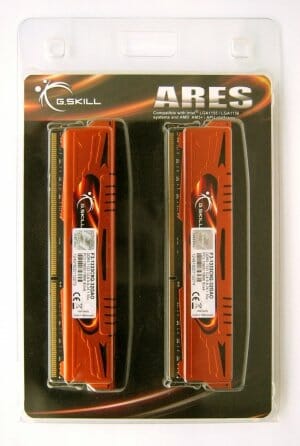
There’s nothing extraordinary about the appearance of these memory modules. They are covered by molded aluminum bars with orange anodizing and pressed-out decorations. There are small notches and cuts in these bars to facilitate heat dissipation. The overall impression from this 4-piece DDR3-1333 memory kit from the Ares series is that it’s a well-made overclocker-targeted product which is compatible with bulky CPU coolers. Large coolers that hang above memory slots won’t conflict with the Ares modules since they are not very tall.
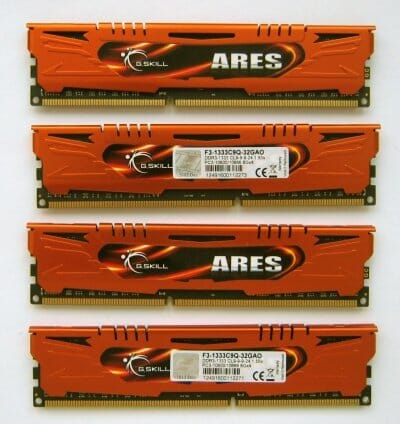
On the other hand, the simple heatsinks aren’t the best choice in terms of cooling efficiency while these modules may get very hot at work. When overclocked, their temperature was up to 62°C during our tests.
Besides the shape and configuration of the heatsinks, this is also caused by the hardware components employed. The G.Skill Ares F3-1333C9Q-32GAO kit uses chips from SpecTek, a Micron subsidiary. Not a widespread variety of memory chips, they have no overclocking reputation and work at their rated frequency in these memory modules. However, the PCB (manufactured by BrainPower) is designed for DDR3-1600 mode, which suggests certain overclocking potential.
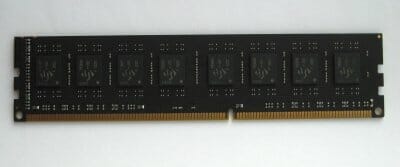
Here are the official specifications of this dual-channel 32GB memory kit:
- 32 GB Dual-channel kit consists of four memory modules, 8 GB each;
- Nominal frequency: 1333 MHz;
- Timings: 9-9-9-24-2T;
- Voltage: 1.5 V.
Besides a low rated frequency, the G.Skill Ares F3-1333C9Q-32GAO has a rather weak selection of timings. This kit lacks XMP profiles because all necessary settings can be easily stored in a standard SPD profile.
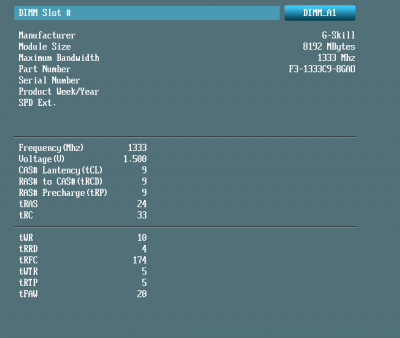
It also means that the G.Skill Ares F3-1333C9Q-32GAO is not going to have any compatibility issues as is confirmed by the extensive list of supported mainboards which includes not only Intel Z77-based models but also mainboards with other Intel chipsets of series 7 and 6.
G.Skill RipjawsX F3-1600C9Q-32GXM
The RipjawsX series appeared in G.Skill’s product range along with the introduction of Intel’s second-generation Core processors, so it was designed for Sandy Bridge CPUs and platforms in the first place. This positioning has changed by now, so today the RipjawsX series includes just high-quality modules for midrange computers. For example, the RipjawsX F3-1600C9Q-32GXM kit we’ve got for our tests has not only LGA2011 and LGA1155 in various modifications but even Socket AM3/AM3+/FM1/FM2 listed as its target platforms.
The packaging is again a dual-sided blister wrap. There’s a colorful paper insert inside, but you can’t read it until you remove the wrap. Well, it doesn’t have anything particularly exciting to tell you, actually. Included with the modules is a small sticker with G.Skill logo.
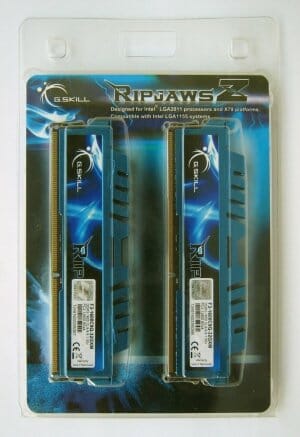
Every module of the G.Skill RipjawsX series features memorable design thanks to their special heatsinks. Originally shaped and efficient, the heatsinks are easy to manufacture and not very large. These figured bars of aluminum only increase the height of the memory modules to 40 mm. The azure-colored anodizing and the colorful stickers with logos make them look pretty whereas their heat dissipation efficiency is improved by means of the intricate shape of their top part. They are secured on the chips with a gluey thermal interface.
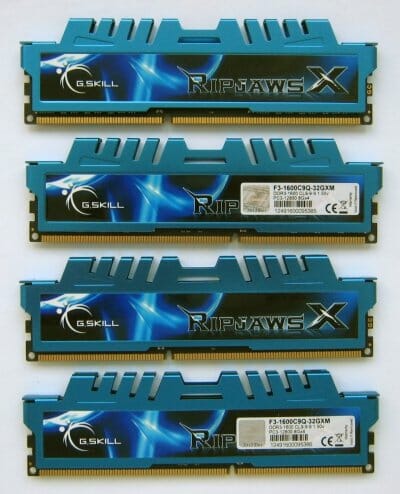
The G.Skill RipjawsX F3-1600C9Q-32GXM kit consists of four 8GB modules, so they take all of the mainboard’s memory slots with but tiny gaps in between. That’s why the notches in the top edge of the heatsinks are so important: the air flows through them, cooling the memory chips. The height of the heatsinks makes them compatible with most air coolers for CPUs. They are going to fit under the cooler into the nearest memory slots, even though barely.
Like the Ares F3-1333C9Q-32GAO, the RipjawsX F3-1600C9Q-32GXM modules are rather hot. Their heatsinks had a temperature of up to 58°C during our tests. So, the heatsinks seem to be an important component of this memory kit, especially as the top temperature is somewhat lower than with the Ares modules.
It is not surprising that the RipjawsX F3-1600C9Q-32GXM modules are so hot since they are based on almost the same chips as the above-discussed Ares. But here we have purebred Micron D9PQL chips which are rebranded (not quite successfully) as SpecTek. According to the official sources, such chips are rated for DDR3-1600 CL11 mode, but the modules are rated for CL9, so there must have been some process of selecting best chips. From this standpoint, the RipjawsX F3-1600C9Q-32GXM is a full-featured overclocker-friendly product that employs specially selected components. The same goes for the high-quality PCB from BrainPower.
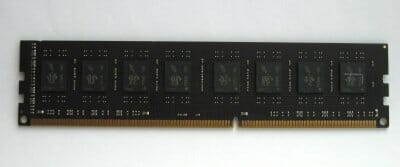
The RipjawsX F3-1600C9Q-32GXM can’t boast extraordinary specs, however. It is a rather typical 32GB DDR3-1600 kit:
- 32 GB Dual-channel kit consists of four memory modules, 8 GB each;
- Nominal frequency: 1600 MHz;
- Timings: 9-9-9-24-2T;
- Supports XMP;
- Voltage: 1.5 V.
These modules do have an XMP profile, so they are not so ordinary after all.
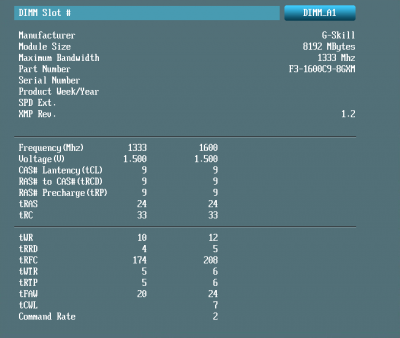
Like any other overclocker-friendly product, the RipjawsX F3-1600C9Q-32GXM kit comes with a lifetime warranty and undergoes presale testing at the manufacturer’s facilities. It claims to be compatible with a large number of mainboards based on Intel’s P67, Z68 and Z77 chipsets.
G.Skill Sniper F3-1866C10Q-32GSR
Interestingly, G.Skill offers different product series for overclockers and gamers. The 4-piece Sniper F3-1866C10Q-32GSR kit is positioned as a gaming product, for example. These modules have a special design of the heatsinks which are stylized as weapon components. Mainboard makers also experiment with the exterior design of their products in such a way, so the G.Skill Sniper series seems to be designed especially for the Sniper mainboard series from Gigabyte.
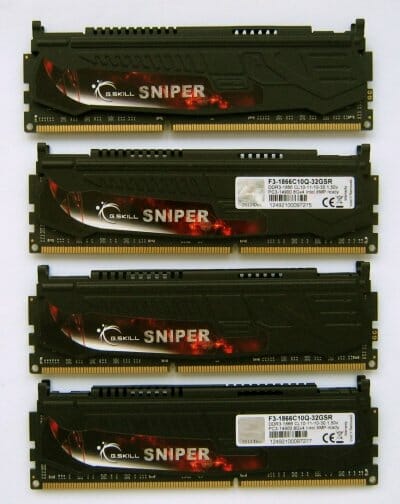
The aluminum heatsinks of the Sniper modules have rough black coating and intricately shaped molded elements. We wouldn’t call them elegant but tastes differ. They are going to be as efficient in terms of cooling as any other heatsinks such as those we’ve seen on the Ares and RipjawsX kits, but the Sniper modules have a total height of 42 mm. This is already too high to guarantee compatibility with tower-design CPU coolers. So if you’re going to buy a G.Skill Sniper kit, you should make sure beforehand that it is compatible with your computer components, especially as the Sniper F3-1866C10Q-32GSR kit needs all four DIMM slots, including the one nearest to the CPU.
The Sniper F3-1866C10Q-32GSR kit is shipped in a dual-sided blister wrap, just like the other products from G.Skill. Besides the modules, there is a sticker with G.Skill logo inside.
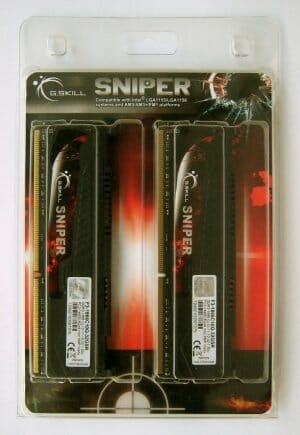
The heatsinks are secured on the Sniper F3-1866C10Q-32GSR modules by means of dual-sided heat-conductive adhesive tape. It is easy to take them off but the original marking is erased from the chips, so we can’t tell you anything about their origin. The PCB is the same as the PCBs of the above-discussed products. It is manufactured by BrainPower.
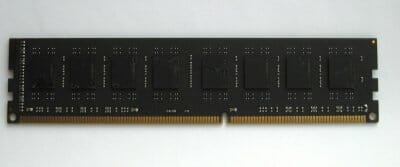
The G.Skill Sniper F3-1866C10Q-32GSR is somewhat different from the other kits in practical applications. It is hot even at its default settings. The heatsinks may be as hot as 55°C and higher whereas the overclocking potential is lower. Well, this product is indeed targeted as gamers, not at overclockers.
Like the other memory kits in this review, this one consists of four identical 8GB modules. Here are the official specs:
- 32 GB Dual-channel kit consists of four memory modules, 8 GB each;
- Nominal frequency: 1866 MHz;
- Timings: 10-11-10-30-2T;
- Supports XMP;
- Voltage: 1.5 V.
To raise the clock rate to 1866 MHz the manufacturer had to lower the timings but the voltage is still 1.5 volts, so the Sniper F3-1866C10Q-32GSR kit won’t strain your memory controller.
XMP is supported in this gaming product. There are even two almost identical profiles that coincide with the official specs.
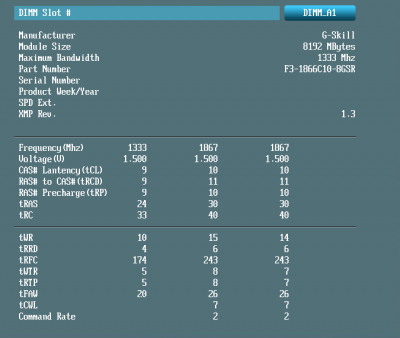
Like the other products from G.Skill, the Sniper F3-1866C10Q-32GSR is shipped with a lifetime warranty. The list of compatible mainboards is impressively long including not only various LGA1155 mainboards but also platforms with the Intel X79 chipset.
G.Skill RipjawsZ F3-2133C9Q-32GZH
The G.Skill RipjawsZ represents further evolution of the RipjawsX series we’ve discussed above. Early RipjawsZ kits were marketed as quad-channel memory for LGA2011 platforms but eventually this name came to be applied to the specific shape of the heatsinks and the RipjawsZ was positioned as dual-channel memory for LGA1155 platforms as well. The F3-2133C9Q-32GZH illustrates that evolution. It was originally meant for X79-based mainboards but the compatibility list was expanded after the release of Ivy Bridge CPUs and now includes a lot of Z77-based mainboards.
The RipjawsZ F3-2133C9Q-32GZH kit is shipped in a plastic blister wrap, just like the other memory kits from G.Skill.
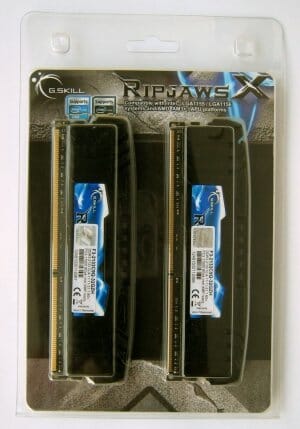
Now let’s take a look at their exterior design. The heatsinks are different from those of the RipjawsX modules. They are still made of aluminum but the color is changed into glossy black. Moreover, the heatsinks have become somewhat more solid, yet the RipjawsZ modules are still not very tall and are not likely to conflict with massive air coolers for CPUs. The full height of each module is 40 mm, exactly as that of the RipjawsX series.
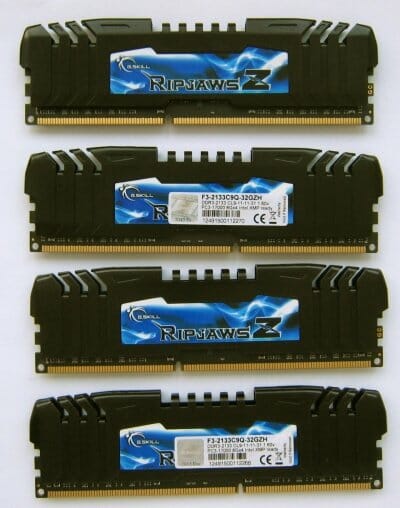
We have no doubts about the cooling efficiency of the RipjawsZ heatsinks. The modules do not get as hot as their cousins whereas the heatsinks are shaped intricately to enlarge the total heat dissipation area.
The heatsinks are secured on the memory chips with a gluey thermal interface material. Below them we can find a BrainPower PCB typical of G.Skill products and specially selected 4-gigabit DDR3 SDRAM chips from Samsung. The components have a good overclocking reputation. The B83U854 1.00 PCB is optimized for clock rates above 2 GHz whereas the SEC HCH9 chips are perhaps the most popular choice for high-speed overclocker-friendly DDR3 SDRAM.
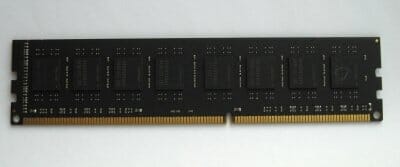
The G.Skill RipjawsZ F3-2133C9Q-32GZH kit seems to be good from every aspect, including its specifications. Its four 8GB modules can work in DDR3-2133 mode which is not covered by the official specs of CPU-integrated memory controllers. Here is the full picture:
- 32 GB Dual-channel kit consists of four memory modules, 8 GB each;
- Nominal frequency: 2133 MHz;
- Timings: 9-11-11-31-2T;
- Supports XMP;
- Voltage: 1.6 V.
The RipjawsZ F3-2133C9Q-32GZH has a slightly increased default voltage but can work at CL9. This is reflected in the duplicated XMP profiles:
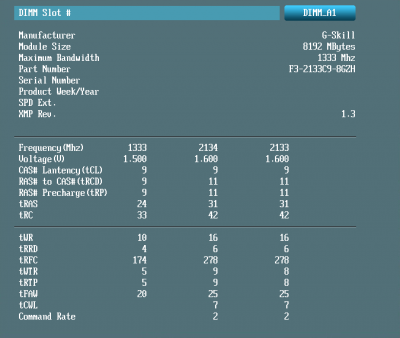
This DDR3-2133 SDRAM kit is a true overclocker-friendly product whose rated mode is beyond standard ones. It undergoes presale testing and comes with a lifetime warranty but G.Skill guarantees its stable operation with only a limited number of mainboards which mostly include flagship models from ASUS, Gigabyte and MSI based on Intel’s Z77 chipset.
G.Skill TridentX F3-2400C10Q-32GTX
G.Skill’s flagship overclocker-friendly products are marketed under the TridentX trademark. Besides extreme specs and a special version of aluminum heatsinks, this series differs from other DDR3 SDRAM in some more ways. The TridentX series was launched along with the Intel Z77 platform, its visiting card being the transformer heatsinks that can change their size and appearance.
Consisting of four 8GB modules of DDR3-2400 SDRAM, the G.Skill TridentX F3-2400C10Q-32GTX has the same packaging as other G.Skill products. It is shipped in a dual-sided blister wrap.
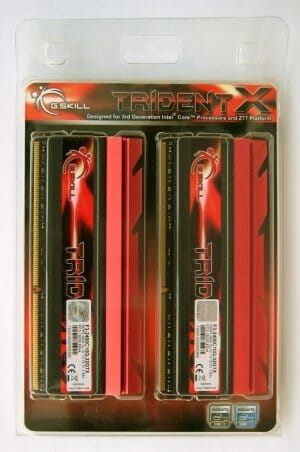
The heatsinks of the TridentX series are completely different from other solutions from G.Skill. Neatly manufactured, they are rather heavy, even though made of aluminum. The bottom part of each heatsink that covers the DDR3 SDRAM chips is a pair of thick black-colored bars with a rough surface. The top part is a red aluminum superstructure with a complex profile stylized as tongues of flame.
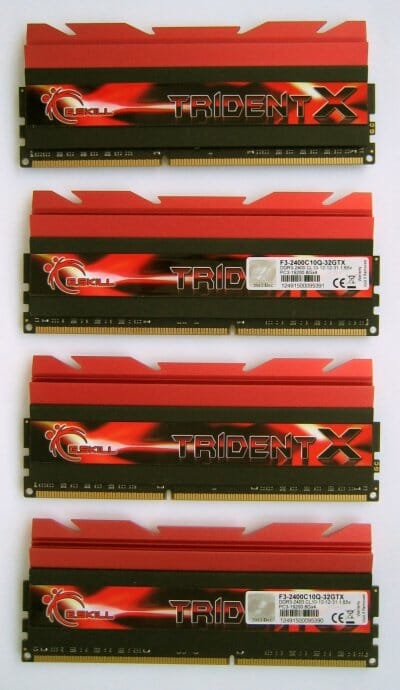
It is not the impressive looks but the transformability that is the key feature of these heatsinks. G.Skill listened to user complaints that tall heatsinks had poor compatibility with massive CPU coolers, so the top (red) part of the heatsink can be removed by unfastening two screws. As a result, the total height of a TridentX module is decreased from 54 to 40 mm, allowing to choose between aesthetics and practicality. In their shortened version, the TridentX modules won’t conflict with regular large-size CPU coolers.
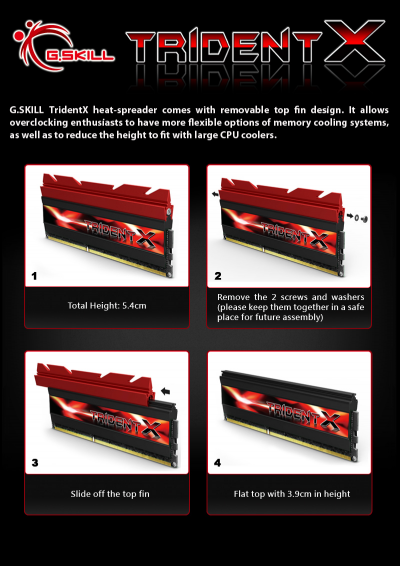
The shortened heatsink is quite sufficient to cool the eight memory chips on both sides of each module. The G.Skill TridentX F3-2400C10Q-32GTX modules aren’t very hot as they are based on 30nm DDR3 SDRAM chips. The top temperature we spotted during our tests was 53°C.
Rated for 2400 MHz, these modules have the same components as the 2133MHz RipjawsZ F3-2133C9Q-32GZH. So, it is all about choosing the best chips. The TridentX employs the same SEC HCH9 components but from a different batch. Thanks to their high overclocking potential and low heat dissipation, these chips have a good reputation and are deservedly employed in high-speed memory modules. The PCB is manufactured by BrainPower again. Each 8GB module has a total of 16 chips, 4 gigabits in capacity each.
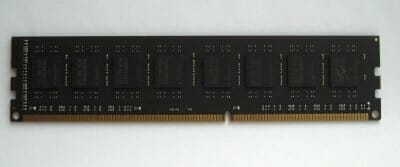
The official specs of the TridentX F3-2400C10Q-32GTX kit are as follows:
- 32 GB Dual-channel kit consists of four memory modules, 8 GB each;
- Nominal frequency: 2400 MHz;
- Timings: 10-12-12-31-2T;
- Supports XMP;
- Voltage: 1.65 V.
The voltage is increased to the maximum limit permitted for Intel’s DDR3 SDRAM controllers, which is normal for high-speed memory. The good news is that the TridentX F3-2400C10Q-32GTX features rather low timings. That’s especially good considering that it’s a 4-piece memory kit.
The high clock rate and CL10 timings narrow the scope of compatible mainboards. G.Skill guarantees the TridentX F3-2400C10Q-32GTX will work with some two dozen Z77-based mainboards from ASUS, Gigabyte and MSI, but we guess there won’t be problems with many other products as well. To simplify installation, these modules support XMP 1.3. The single XMP profile (it is duplicated for more stability) contains the same clock rate, voltage and timings as you can see in the official specs. Considering that the Ivy Bridge memory controller is flexible and easy to configure, launching this memory at 2400 MHz won’t be a problem at all. You won’t have to do any setting up with this memory kit but their SPD unit contains DDR3-1333 settings just in case.
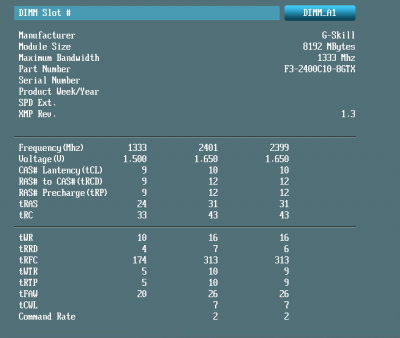
All TridentX F3-2400C10Q-32GTX modules under presale testing at the manufacturer’s facilities and come with a lifetime warranty.
Testbed Configuration
Since the primary target platform for the above discussed memory kits is Ivy Bridge + Intel Z77, we will test 32 GB G.Skill kits consisting of four 8 GB modules each in an LGA 1155 system built on Asus P8Z77-V Deluxe mainboard. Since overclocking memory modules reviewed today are primarily purchased by enthusiasts, we also used Intel Core i5-3570K processor overclocked to 4.5 GHz.
As a result, the complete list of hardware and software components in our testbed looked as follows:
- CPU: Core i5-3570X, overclocked to 4.5 GHz (Ivy Bridge, 4 cores, 6 MB L3);
- CPU cooler: NZXT Havik 140;
- Mainboard: ASUS P8Z77-V Deluxe (LGA 1155, Intel Z77 Express);
- Memory:
- G.Skill Ares F3-1333C9Q-32GAO (4 x 8 GB, DDR3-1333, 9-9-9-24);
- G.Skill RipjawsX F3-1600C9Q-32GXM (4 x 8 GB, DDR3-1600, 9-9-9-24);
- G.Skill Sniper F3-1866C10Q-32GSR (4 x 8 GB, DDR3-1866, 10-11-10-30);
- G.Skill RipjawsZ F3-2133C9Q-32GZH (4 x 8 GB, DDR3-2133, 9-11-11-31);
- G.Skill TridentX F3-2400C10Q-32GTX (4 x 8 GB, DDR3-2400, 10-12-12-31).
- Graphics card: Nvidia GeForce GTX 680 (2 GB / 256 bit GDDR5, 1006/6008 MHz);
- Drive: Intel SSD 520 240 GB (SSDSC2CW240A3K5);
- Power supply unit: Corsair AX760i (80 Plus Platinum, 760 W);
- Operating system: Microsoft Windows 7 SP1 Ultimate x64;
- Drivers:
- Intel Chipset Driver 9.3.0.1026;
- Intel Management Engine Driver 8.1.2.1318;
- Intel Rapid Storage Technology 11.7.0.1013;
- NVIDIA GeForce 314.09 Driver.
Configurations with 4 x 8 GB Memory Kits: Closer Look
Before we get down to testing the memory kits described above, we want to dwell upon general issues of using dual-channel kits consisting of four 8GB modules. Although we wrote above that the Ivy Bridge memory controller can easily support such configurations, there are some nuances you should be aware of.
First of all, not all operating systems are ready to support 32 gigabytes of system memory. Of course, you need a 64-bit OS because 32-bit ones cannot access more than 4 gigabytes of address space. Besides, certain 64-bit Windows versions have specific limitations. For example, Windows 7 Home Premium supports only 16 GB whereas Windows 7 Home Basic, 8 GB. Windows 8 has no such limitations, supporting at least 128 GB of system memory in each of its versions.
Second, it’s not correct to say that Ivy Bridge CPUs are indifferent to whether you have four or two memory modules. Clocking the memory bus at a high frequency may require your lowering the Command Rate parameter. So if the mainboard has only two DIMM slots filled in, the memory subsystem nearly always can work at Command Rate = 1T. With four modules installed, you can only choose 1T at speeds up to DDR3-2000 inclusive. Faster memory configurations will call for Command Rate = 2T.
The Command Rate parameter isn’t crucial, though. It can often be disregarded completely. Describing the latency between receiving and decoding addresses and instructions, it helps eliminate potential access errors at high loads on the memory controller. Its effect on memory performance is very low. Comparing two memory configurations – two modules with Command Rate 1T and four modules with Command Rate 2T – we can find the second to be even faster as it includes more memory banks.
It is easy to illustrate with tests we carried out using the 32GB DDR3-2133 SDRAM kit RipjawsZ F3-2133C9Q-32GZH. First, we ran it at its default timings of 9-11-11-31-2T and then we took only two modules and improved the timings to 9-11-11-31-1T. Here are the results:
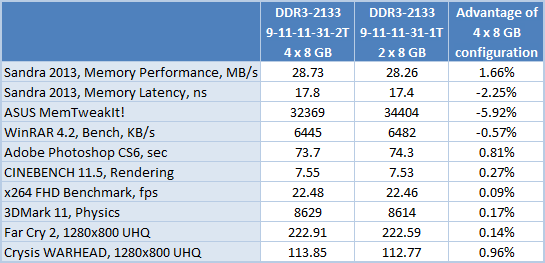
As you can see, the two configurations are very close to each other in performance. So, there is no reason to worry about having to set Command Rate = 2T with four memory modules. The internal organization of the 4-piece memory subsystem makes up for that.
Yet another peculiarity of 4-piece 32GB memory kits is that they generate quite a lot of heat. We used to say that heatsinks for DDR3 modules are largely just a decorative element, but they are actually necessary for overclocker-friendly kits made of four 8GB modules. Such modules have a lot of chips and are located close to each other on the mainboard, inhibiting the natural convection of air. As a result, the temperature may rise very high. So, it’s good to have heatsinks, especially with advanced finning, on such memory modules.
The heatsinks must not be too tall, however. When you fill in all of your mainboard’s memory slots, the one nearest to the CPU socket is going to be covered by the CPU cooler. So, the latter should be able to hang above the memory modules without pressing against their heatsinks. The list of compatible CPU coolers shrinks considerably when the memory modules have a total height of over 40 mm.
Overclocking
As we shown in our special review of the memory controller in modern LGA1155 CPUs, it is the operating frequency of dual-channel memory kits that has the biggest effect on the platform’s performance. Therefore, increasing it above standard levels is the key feature of overclocker-friendly memory kits that helps ensure an additional performance boost.
The G.Skill memory kits are promising in terms of overclocking potential. Even though they include twice the normal number of DDR3 SDRAM modules, they feature efficient cooling and high-quality chips. G.Skill is also known to endow its products with a large safety margin. All of this gives us hope that these modules can work at higher clock rates than specified officially and may prove that there’s nothing wrong about using a 4-piece memory kit on a platform with a dual-channel memory controller.
Here’s our algorithm of testing the overclocking potential of DDR3 SDRAM:
- Memory voltage is increased to 1.65 volts which, according to Intel, is the maximum value that doesn’t lead to degradation in the memory controller’s performance. We also increase the VCCSA voltage to 1.0 volts, which should theoretically have a positive effect on the memory controller’s stability;
- Failsafe timings of 11-13-13-31-2N are selected to find out the highest frequency the memory kit is stable at;
- Using the maximum frequency we’ve found, we then look for the most aggressive timings at which the memory kit is still stable.
The stability of the memory subsystem is verified by 10 runs of LinX 0.6.4 AVX Edition using the whole memory amount and by an additional 1-hour-long check with Memtest86+ v4.20.
G.Skill Ares F3-1333C9Q-32GAO
The simplest of our 32GB memory kits from G.Skill isn’t so bad at overclocking. Well, with the current level of technology, it is rather hard to make DDR3-1333 SDRAM chips incapable of working at higher frequencies. The Ares F3-1333C9Q-32GAO can actually be used not only as DDR3-1600 but also as DDR3-1866.
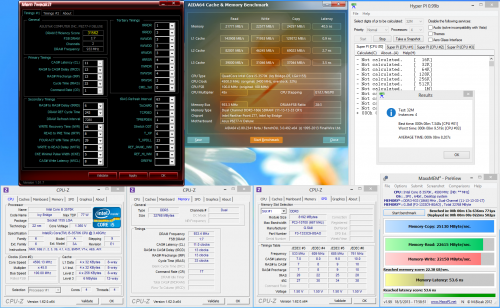
We had to relax the timings and increase the voltage to 1.65 volts to make them stable at 1866 MHz, so the Ares F3-1333C9Q-32GAO kit should indeed be viewed as an inexpensive solution for when you need a large amount of system memory.
G.Skill RipjawsX F3-1600C9Q-32GXM
Besides the beautiful color of their heatsinks, the RipjawsX F3-1600C9Q-32GXM modules can distinguish themselves with their overclocking potential. After increasing their voltage to 1.65 volts, we managed to achieve stability in DDR3-2133 mode. That’s what we can expect from the Micron chips which are so popular among enthusiasts.
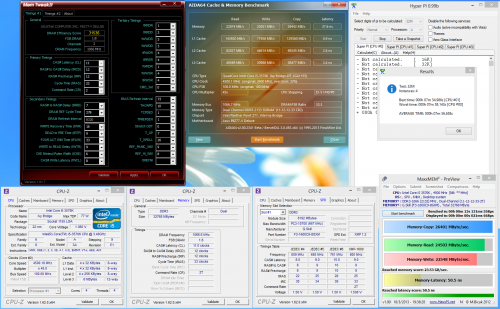
The lowest timings the RipjawsX F3-1600C9Q-32GXM kit was stable at in DDR3-2133 mode were 11-12-12-33. You can also note that we had to switch the Command Rate parameter to 2T. Choosing a lower value for it caused memory errors at high loads.
G.Skill Sniper F3-1866C10Q-32GSR
Describing the Sniper series kit above, we noted that it is meant for gamers rather than for overclockers. Therefore, we were not surprised at its low overclocking potential. The Sniper F3-1866C10Q-32GSR kit is rated for DDR3-1866 and we could only raise the clock rate by 133 MHz even at a voltage of 1.65 volts.
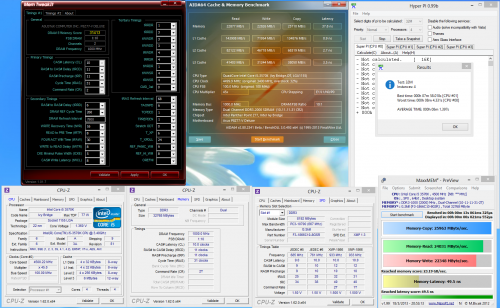
On the other hand, this memory could work as DDR3-2000 with CL = 10, i.e. with its timings close to their defaults. The unnamed chips below the heatsinks of the Sniper F3-1866C10Q-32GSR modules seem to have been tested by G.Skill to be appropriate for the product’s market positioning.
G.Skill RipjawsZ F3-2133C9Q-32GZH
High-speed memory kits for computer enthusiasts can but rarely show high overclocking potential because they already make the most of the employed chips. It is even more difficult with 4-piece memory kits just because they include more memory devices. It is quite an achievement that our DDR3-2133 kit RipjawsZ F3-2133C9Q-32GZH was stable at 2200 MHz in our tests.
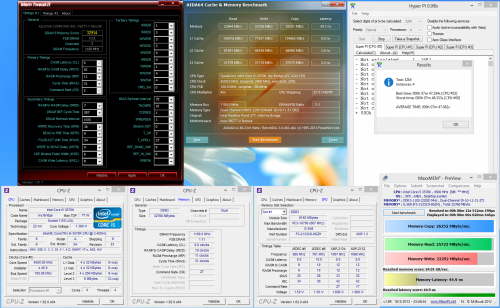
Moreover, we could even improve its timings. The default timings are 9-11-11-31 but our RipjawsZ F3-2133C9Q-32GZH kit could work at 9-10-11-31 at the increased clock rate.
We can also note that we’ve tested a number of memory products from different brands with SEC HCH9 chips. Like the RipjawsZ F3-2133C9Q-32GZH, such modules can usually be overclocked to 2200-2600 MHz, so the G.Skill product is quite a typical representative of its class.
G.Skill TridentX F3-2400C10Q-32GTX
The fastest 32GB memory kit in this review is rated for 2400 MHz. It must be noted that G.Skill has recently announced DDR3-2800 kits, but doesn’t yet really offer them at the time of our writing this. This might give us some hope that the TridentX F3-2400C10Q-32GTX could be overclocked a little, but that’s not so. Our sample of this memory kit wouldn’t work even at 2600 MHz.
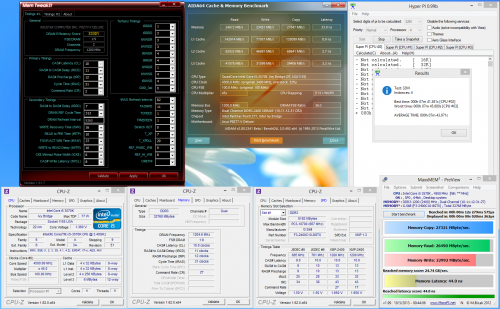
So, there was no overclocking actually. We could only lower RAS# to CAS# Delay a little, dropping the timings to 10-11-12-31. Overall, the TridentX F3-2400C10Q-32GTX has zero overclocking potential but that’s no downside. It is just a characteristic feature of any memory modules which are rated for high frequencies. Their memory chips are already overclocked to the limit without our intervention.
The results of our overclocking experiments are summed up in the following table:
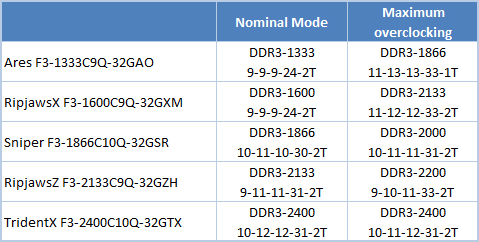
Apart from the Ares F3-1333C9Q-32GAO kit which has low official specs, the memory kits from G.Skill are similar in their overclocking potential. All of them can be overclocked to above 2 GHz, i.e. to speeds which are most popular among enthusiasts. Of course, memory rated for a lower default frequency has better relative overclocking potential. The high-speed modules do not overclock well but feature SEC HCH9 chips that enjoy an excellent reputation among overclockers.
Performance
In our performance tests we checked out the speed of our LGA1155 platform with different dual-channel 32 GB memory kits from G.Skill. Each kit was tested in two modes: 1) automatic configuring when every timing is set by the mainboard’s BIOS according to the XMP data or official specifications (for Ares F3-1333C9Q-32GAO, which doesn’t support XMP) and 2) with highest clock rates and best timings (as achieved in our overclocking tests above) set up manually in the mainboard’s BIOS.
First of all we want to run synthetic benchmarks of memory bandwidth and latency. We will use two tools for that. One is the memory test from SiSoft Sandra 2013. Using a multithreaded Stream algorithm, it is perfectly suited to modern memory controllers optimized for multi-core CPUs.
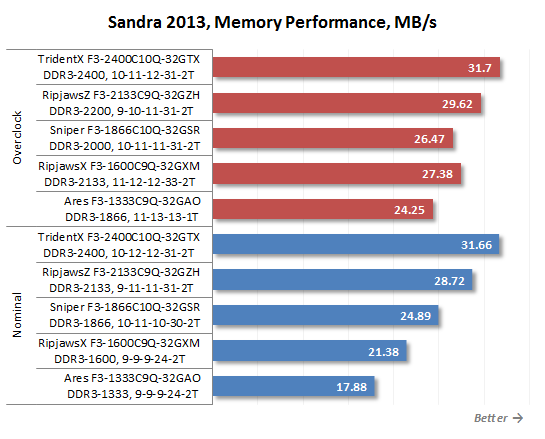
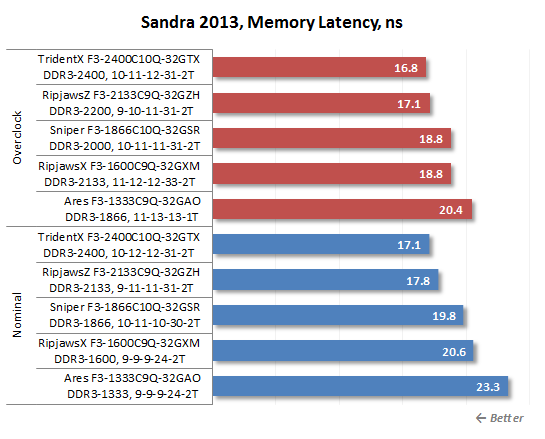
And the other is the integrated test from the ASUS MemTweakIt! utility which issues a single number indicative of the overall memory subsystem performance.
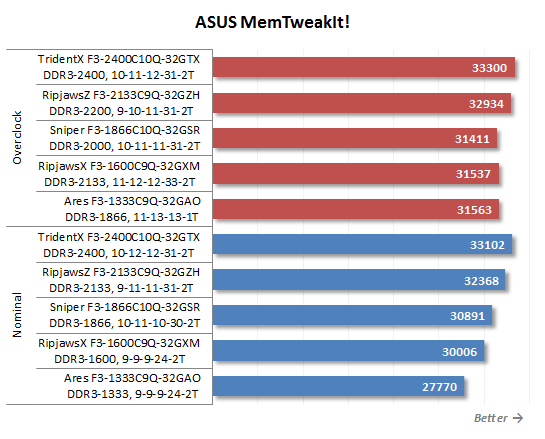
The clock rate of DDR3 SDRAM has a rather strong influence on memory subsystem performance in platforms with Ivy Bridge CPUs. For example, increasing that clock rate by 333 MHz improves the practical memory bandwidth by 10-20% and reduces latency by 5-15%. Both frequency and timings affect latency whereas bandwidth doesn’t depend much on timings.
We can also note that four 8GB memory modules turn out to be no worse than two DDR3 SDRAM modules in terms of practical memory subsystem performance. We can see this easily by using data from our previous tests. For example, the DDR3-2400 memory kit Corsair Dominator Platinum CMD16GX3M2A2400C10 (consisting of two 8GB modules and with timings of 10-12-12-31) had a bandwidth of 31.21 GB/s and a latency of 16.8 ns in Sandra 2013, which is even worse than the results of the G.Skill TridentX F3-2400C10Q-32GTX kit which has the same specs but consists of four 8GB modules.
The SiSoft Sandra 2013 and ASUS MemTweakIt! results suggest that it makes practical sense to be particular about choosing DDR3 SDRAM modules. However, these are synthetic benchmarks which are meant to measure how fast the CPU can work with system memory. Everyday applications are not so memory-sensitive, yet we want to check them out as well.
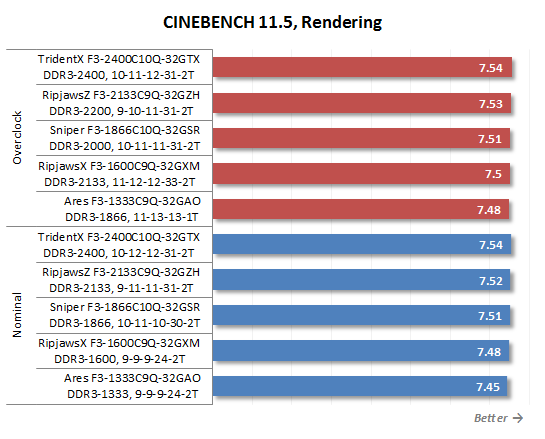
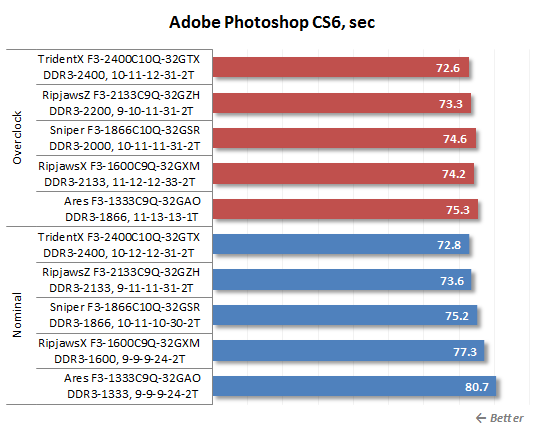
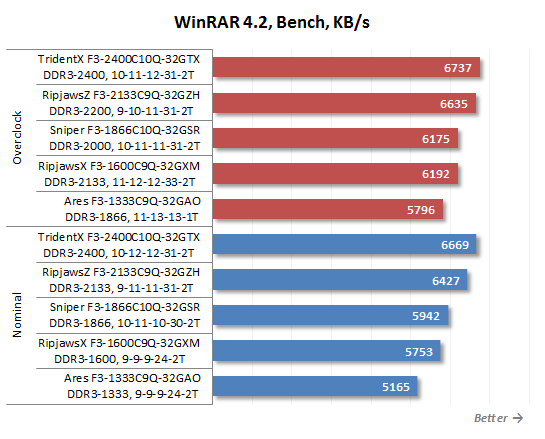
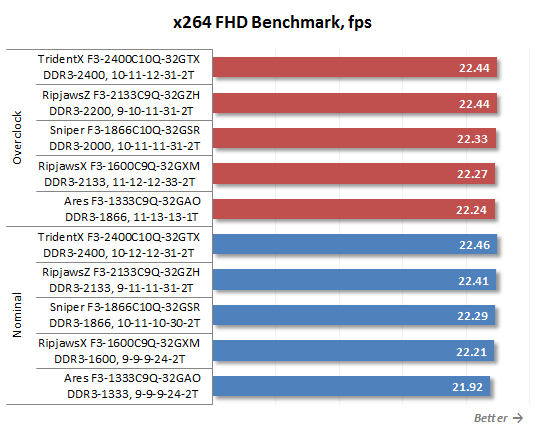
Fast overclocker memory is indeed appropriate in some situations, especially if it is priced very similarly to the regular mainstream memory kits. Memory subsystem parameters can affect the speed of gaming applications, for example.
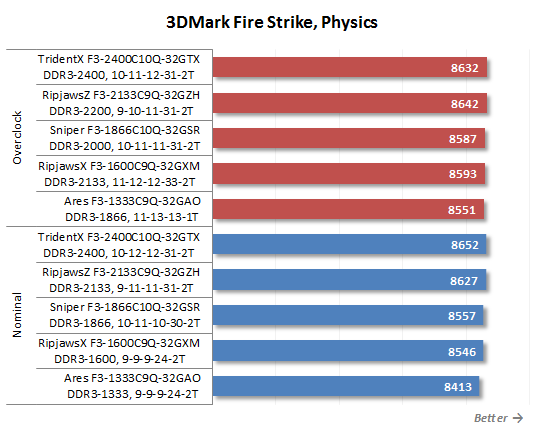
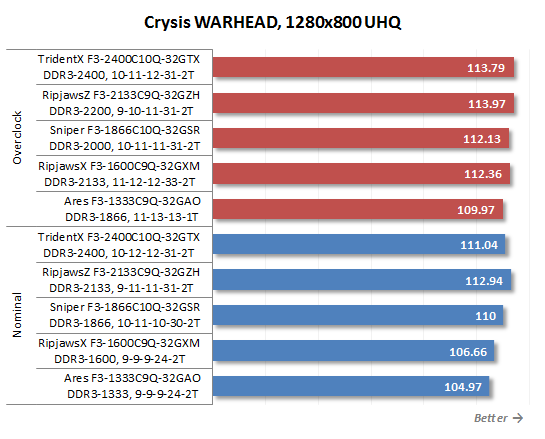
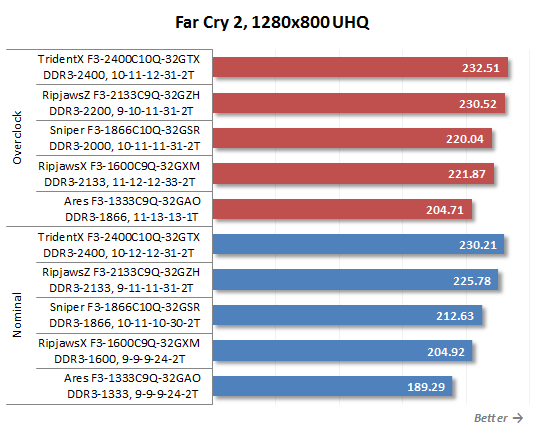
Of course, it is the graphics subsystem that influences the frame rate the most, but the memory frequency is a factor, too. Fast memory can help you improve performance by a few percent. So again, the choice of DDR3 SDRAM is quite important, and the main parameter to consider in this case is DDR3 SDRAM frequency.
As for the sheer capacity offered by these 32GB memory kits, it doesn’t provide any benefits in terms of speed. Everyday computing tasks do not call for so much memory, but it may come in handy in special cases, for example if you process large high-resolution images or use virtual machines. On the other hand, there is no reason why you shouldn’t indulge yourself by purchasing more system memory for the future, just in case, especially as the products discussed in this review will only cost you $200-300.
Conclusion
Although we’ve only tested products from G.Skill in this review, we can make a far more general conclusion. We’ve made sure that today’s dual-channel memory controllers integrated into Ivy Bridge CPUs can easily work with four-module DDR3 SDRAM configurations, with two modules per channel. There are no performance or compatibility issues. You can use four modules in the same operation mode as you would use two.
So, high-capacity 4-piece DDR3 SDRAM memory kits designed for Ivy Bridge platforms are highly attractive for enthusiasts. On the one hand, it’s good to have more memory, especially when it comes at such a low price as today. Therefore, if you desire to have an advanced PC configuration, you may want to seriously consider a 32 GB memory kit of four 8 GB modules.
As for G.Skill specifically, this memory maker currently offers the broadest selection of such kits of all (for platforms with four DIMM slots). Most of the available G.Skill kits have highly attractive specs. And I am not only talking about frequencies and timings, which may vary in a wide range and go as high as DDR3-2400. G.Skill also offers high-quality chips and PCBs with good pedigree.
Talking about the specific products we’ve tested today, we want to single out two of them. First of all, it is the G.Skill RipjawsX F3-1600C9Q-32GXM kit which is rated for DDR3-1600 but has an impressively high overclocking potential. Most importantly, it is one of the most inexpensive 32 GB memory kits available today.
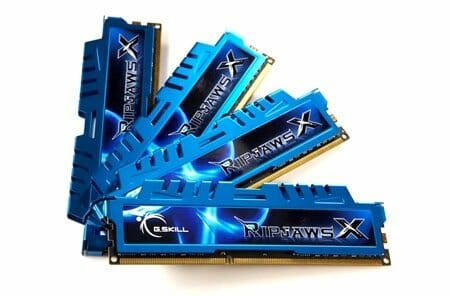
And secondly, the G.Skill TridentX F3-2400C10Q-32GTX has excellent nominal specifications and can work as DDR3-2400 with CAS Latency = 10. However, its key feature is the unique design of its heat-spreaders, which can be either tall and pretty or may be quickly transformed into low-profile ones to ensure compatibility with any CPU cooler.
